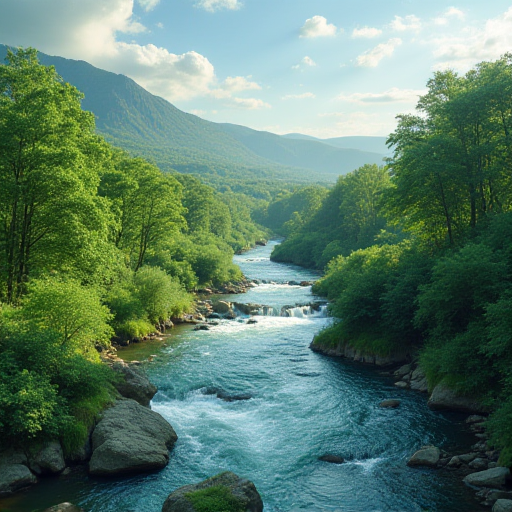
Why Do Rivers Flow?
Rivers are among the most dynamic and life-sustaining features of the Earth's surface. They carve through landscapes, transport nutrients, and provide habitats for countless species. But what exactly causes rivers to flow? Understanding the mechanics behind river flow involves exploring a combination of geological, hydrological, and meteorological factors. This article delves into these elements to explain why rivers flow.
The Hydrological Cycle
At the heart of river flow is the hydrological cycle, a continuous movement of water on, above, and below the surface of the Earth. This cycle includes:
- Evaporation: Water from oceans, lakes, and rivers evaporates into the atmosphere, turning into water vapor.
- Condensation: As water vapor rises, it cools and condenses to form clouds.
- Precipitation: Water falls back to the Earth as rain, snow, sleet, or hail.
- Infiltration and Runoff: Some of the precipitation infiltrates the ground, replenishing aquifers, while the rest flows over the surface as runoff, feeding into rivers and streams.
This cycle is powered by solar energy, which drives the evaporation and atmospheric circulation that transports moisture across the globe. Rivers are key conduits in this cycle, channeling precipitation from land back to the oceans.
Gravity: The Driving Force
The primary force that causes rivers to flow is gravity. Water moves from regions of higher elevation to lower elevation due to gravitational pull. This is why rivers typically originate in mountains or highlands and flow towards oceans, seas, or lower-altitude areas. The gradient, or slope of the land, determines the speed and direction of river flow. Steeper gradients result in faster flows, while gentler slopes lead to slower-moving rivers.
River Sources
Rivers begin in various ways, each influencing their flow:
- Glacial Melt: Many rivers originate from glaciers. As glaciers melt, they release water that gathers into streams and rivers. The seasonal nature of glacial melt can affect river flow rates.
- Spring Sources: Underground water sources can emerge as springs, providing a continual supply of water to rivers.
- Rainfall and Snowmelt: Direct precipitation and melting snow contribute significantly to river flow, especially in regions without glaciers or significant underground water sources.
Geographical Influences
The topography and geology of a region significantly influence river flow:
- Riverbed Composition: The material of the riverbed, such as rock, gravel, or soil, affects how easily water flows. Rocky beds can lead to turbulent flow, while sandy or silty beds might encourage slower, meandering rivers.
- Obstructions: Natural obstructions like boulders, fallen trees, or human-made structures such as dams can alter the flow of a river, creating pools or rapids.
Seasonal Variations
River flow is not constant throughout the year. Seasonal changes can significantly impact the volume and speed of a river:
- Wet and Dry Seasons: Many rivers experience high flow during rainy seasons and reduced flow during dry periods.
- Snowmelt: In temperate regions, spring snowmelt can lead to increased river flow, sometimes resulting in floods.
Human Impact
Human activities also play a role in river flow:
- Dams and Reservoirs: Constructing dams alters the natural flow of rivers, often creating reservoirs that store water for human use.
- Irrigation and Water Extraction: Diverting water for agriculture or urban use reduces the amount of water flowing downstream.
- Climate Change: Alterations in climate patterns are affecting hydrological cycles worldwide, leading to changes in river flow due to altered precipitation patterns and increased evaporation rates.
Conclusion
Rivers flow due to a complex interplay of natural forces and processes. Gravity drives water from high to low elevations, while the hydrological cycle ensures a continual supply of water. Geographic features and seasonal changes further influence the behavior and characteristics of river flow. Understanding these factors is crucial for managing water resources and preserving the ecological health of river systems. As human-induced changes continue to impact the environment, understanding why rivers flow becomes increasingly important for ensuring their sustainability and the services they provide to ecosystems and human societies.
